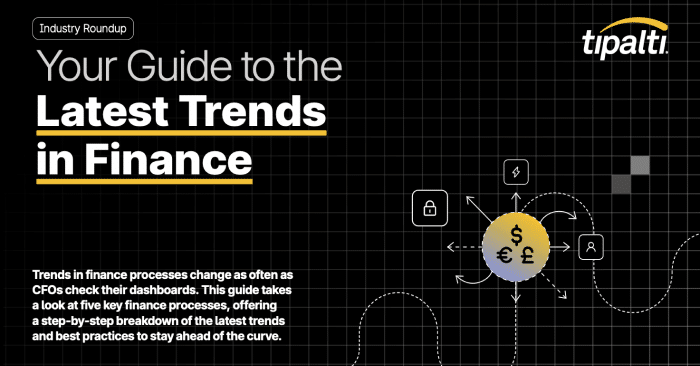
Finance trends shift fast—explore 5 key processes & tips to stay ahead.
Fill out the form to get your free eBook.

Trends in finance processes change as often as CFOs check their dashboards. This guide takes a look at five key finance processes, offering a step-by-step breakdown of the latest trends and best practices to stay ahead of the curve.
73% of businesses are running at least one application on the cloud.
It’s a far cry from the 90s—when people were planning for complete technological annihilation at the hands of Y2K.
Today, there’s a sense of trust with automation—technology can not only help your business but propel it toward success.
A Case of David & Goliath
For small to mid-size companies, automation was unattainable pre-2006. If you wanted to streamline specific processes, you had to install a clunky and complicated solution that, typically, only large companies could afford.
Software as a Service (Saas) has had a tremendous impact on the industry as a whole.
Smaller companies can execute and deliver significant value to their customers through the cloud—they can operate at the level of enterprises.
Now, industry behemoths like IBM and Microsoft no longer monopolize the industry. Because of the cloud, resources that were only previously attainable to large companies are widely available across the board. The sheer magnitude of accessible automation tools, whether for Sales, Marketing, Finance, or HR, can be accessed by companies of all sizes.
It’s the new-age “level playing field,” and small to mid-size businesses are taking advantage of the opportunity—striving to provide services that offer better workflows and controls than larger organizations.
Adopting a Cloud-First Strategy
In the early days of Saas, companies were vigilant about protecting their data. They believed the cloud wasn’t secure, and that their data was too important—changing wasn’t a good idea.
In reality, the cloud is more secure than hosting everything in-house. There is more availability and security, and modern businesses are taking note. Today, it’s part of an organization’s DNA to implement technology as a way to compete at a higher level.
And small businesses aren’t the only ones adopting a cloud-first data strategy. From large corporations to investment banks and governments, more organizations are comfortable with putting sensitive data on the cloud.
Plus, automation has more benefits than just cost savings and security—streamlining manual processes frees up your company’s most valuable asset: talent.
The Race for Talent
Inefficient, manual operations are labor-intensive, and most small to mid-size businesses need to save resources. If your team is executing manually on tasks that can be automated, you’re wasting cycles, and those clunky processes will hold your company back.
For Example: If your VP of finance or CFO is dealing with Accounts Payable tasks, that’s not a core strategic function for them—it’s not where they should be spending their time. An employee at that high-level should focus on scaling, efficiencies, and international expansion. A finance leader that is spending their time on AP is not reaching the full extent of their strategic impact.
The cloud can automate these tasks. If you provide the right technology tools, automation allows your entire team to be more strategic and impactful. Being inundated with just the tactical and mundane is no longer a burden. Instead, you’re able to focus on work that truly elevates the business.
It’s not the 90s anymore—we might still be listening to Nirvana and doing the Macarena, but our tech tools are not stuck in the past. Automation is no longer unattainable. For both the large and small, the inefficient days are behind us, and the future is decidedly cloud-first.
